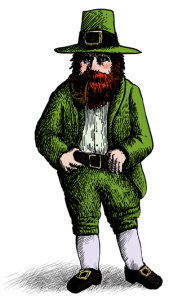A Wee Bit Of Leprechaun Lore
Written by Mac Watson on March 10, 2023
Leprechauns are always associated with St. Patrick’s Day, (which is coming up on March 17th,) the Luck of the Irish, and the guarding of a pot of gold at the end of a rainbow. But just how did this diminutive, troublemaking, up-to-no-good creature (is it an elf? a sprite? something sinister?) come to still be recognized and celebrated in our own modern zeitgeist?

For answers, one must go back to the 8th century in Ireland. A “leprechaun” is from the Irish folklore that describes a fairy who took on the visage of a tiny, old man, often wearing a cocked hat and a leather apron. Preferring to live alone, leprechauns are said to live in remote places, making shoes and brogues. If someone were to keenly listen, the sound of his hammering could give him away. Usually, leprechauns possess a hidden pot of gold that folklore says is stashed away for safe keeping, sometimes at the end of a rainbow. Also folklore says that if the tiny man is threatened with bodily harm, he would often bargain with the person who held him captive. But keep a keen eye on him, because if his captor keeps watch, the leprechaun can reveal where the gold is stashed away. But usually, the captor is tricked into glancing away and the fairy vanishes to keep his gold another day. In fact, in McAnally’s 1888 account, the leprechaun was not a professional cobbler, but was frequently seen mending his own shoes, as “he runs about so much he wears them out” with great frequency. This is, he claims, the perfect opportunity for a human being to capture the leprechaun, refusing to release him until the leprechaun gives his captor supernatural wealth.
Yes, leprechauns are part of the “fairy” family. Fairy, also spelled faerie or faery, is a mythical being that history has passed down through folklore to our own modern times. Fairies can have a special relationship with humans, usually possessing magical powers and dwell on the earth. Fairies can appear like a dwarf-like creature with having green clothes, hair of fiery red or green, living in stone heaps or underground. Characteristically they use their magical powers for benevolent ends.
While the term “fairy” goes back to the Middle Ages in Europe, they have appeared in oral and written traditions, from the Sanskrit celestial musicians to the nymphs of Greek mythology and Homer. Fairies, or something like them, have also appeared in the jinni or Arabic mythology, and similar folk characters of the Samoans, people in the Arctic and indigenous Americans.
The modern depiction of fairies is usually found in children’s stories and represents what was once a serious or even sinister folkloric tradition. In the past, fairies were thought of as dangerous creatures that could not be trusted. Sometimes they could be friendly toward humans but could also be cruel and mischievous.
Although fairies are characteristically thought of as beautiful or handsome creatures, as far as leprechauns go, not so much. Fairies are said to be of human size or smaller, down to a height of three inches or less. Female fairies may tell fortunes, particularly prophesying at births and foretelling deaths. Several herbs, especially St.-John’s-wort and yarrow, are potent against fairies, and hawthorn trees, foxglove, and groundsel are so dear to them that abuse of these plants may bring retribution.
The word “leprechaun” derives ultimately from Old Irish luchorpan, or “little body.”
And remember that the Big Horn Radio Network is encouraging kids to drop off their Leprechaun Lure trap at the Park County Library in Cody for prizes. For more details, click here.




